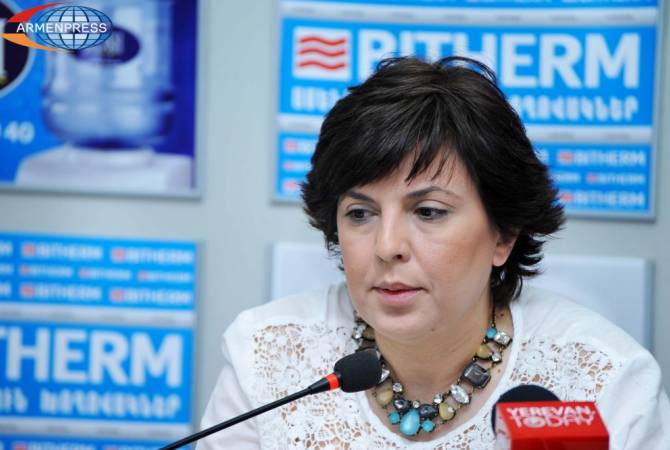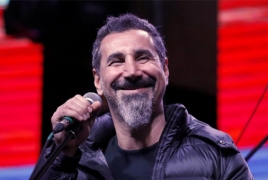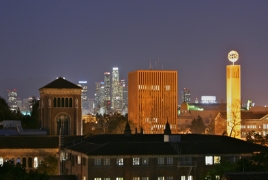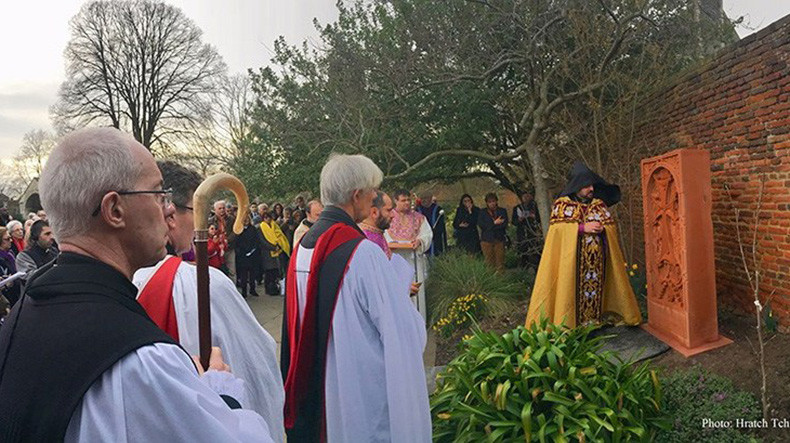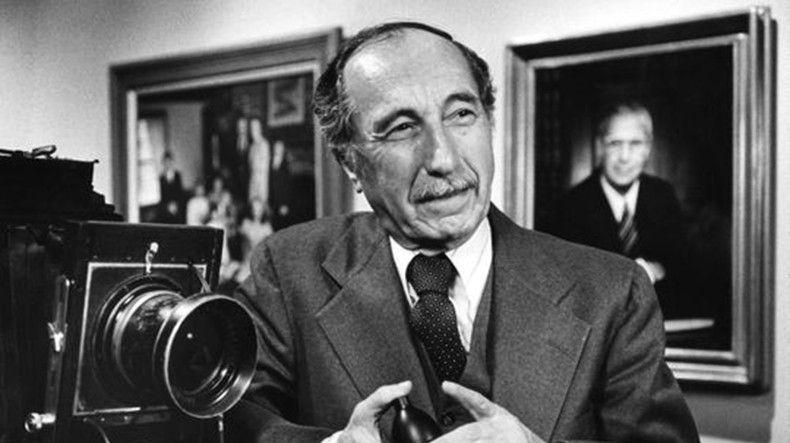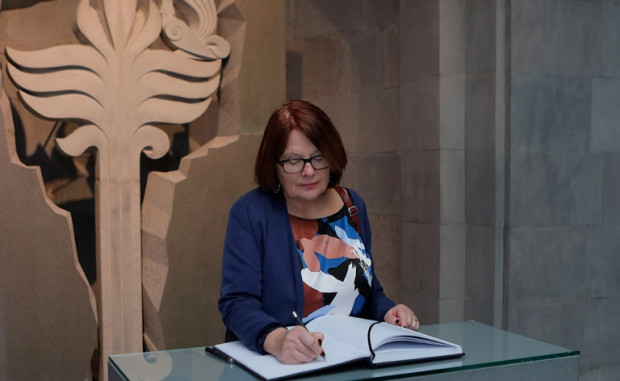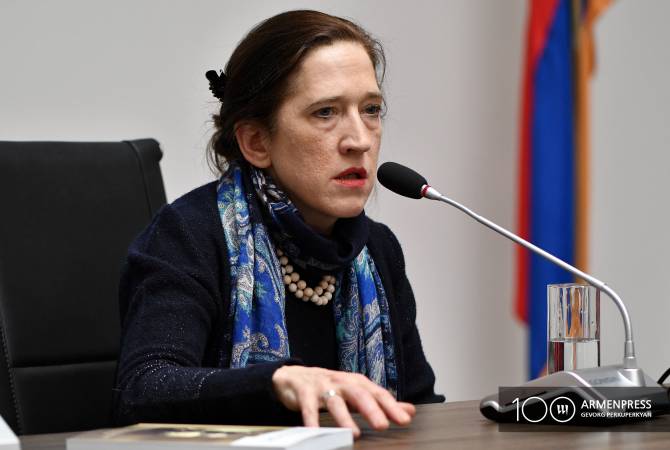Feb. 28, 2019 (The Bridgehead) - The January sun was shining on Istanbul’s Sultanahmet Square as I walked by small piles of scrabbling pigeons, passed the gleaming white Obelisk of Theodosius, and headed through the metal detector that guards the door of the Turkish-Islamic Arts Museum. It is a long building of rose-colored brick and stone, fronted by a row of high arched doorways lined with black bars and clusters of green bushes and the occasional palm tree. It is built on the remains of the ancient Roman hippodrome, restored centuries later by Sultan Suleyman the Magnificent as a gift to his grand vizier and childhood friend, Pargali Ibrahim Pasha. The vizier, unfortunately, was strangled in 1536 when the sultan’s wife decided his influence posed too much of a threat to her own and persuaded her husband to have him killed.
But it was not this morbid history that I came here to explore. I have been researching the Armenian Genocide for some time, and I was searching for the one building in Istanbul that each historical account pinpoints as hosting the first Armenian intellectuals arrested on Red Sunday, the day now recognized as the opening act of the genocide that would consume 1.5 million souls: 90% of Turkey’s Armenian population. It began on April 24, 1915 when Minister of the Interior Talaat Pasha gave the fateful order and hundreds of Armenians were hunted down throughout the city. It was intended as a “decapitation strike” to devastate the Armenian leadership with a single blow.
Beginning at 8 pm. and stretching through to the wee morning hours of April 25, Constantinople’s Armenian clergymen, doctors, journalists, lawyers, teachers, and politicians were jerked from their beds, dragged from their homes, and locked up in Istanbul’s infamous Central Prison. It took days for me to locate where, exactly, the Central Prison stands today. I finally discovered where it was in an article from 2013 in the Armenian Weekly detailing a protest in front of the Museum that included the names of lost Armenian villages, places swallowed by the bloody events that followed Red Sunday, being listed defiantly through a loudspeaker. As it turns out, the Central Prison is now known as the Turkish-Islamic Arts Museum.
There was some sort of fancy reception going on in the foyer when I entered, replete with chortling patrons stuffed into straining tuxes, solemn waiters gliding about with trays of obviously expensive tidbits, and the self-satisfied smiles of men and women who are aware that they have made it. Cameras were clicking frantically, so apparently at least some of them were important. I squeezed through the clusters of well-clad posteriors, passed through the sparsely-stocked giftshop, and headed to the enormous plaque affixed to the wall at the foot of the stairs that led to the courtyard. In tiny letters, the history of the Museum was detailed at length. There was no mention of the building ever being known as Central Prison.
I carefully combed the displays, which were set up meticulously in exhibition halls accessible by low doorways lining the long brick corridors. I tried to imagine what the view of the imprisoned Armenian intellectuals might have been as I noted the woven rugs, the beautiful pottery, the ancient illuminated Korans. One section hosts Islamic relics, and a young father was hunched next to a glass display case, pointing reverently at a tiny glass cylinder with gold engravings on either end. His little girl was staring with wide eyes: The cylinder, apparently, contains a holy hair from the beard of the Prophet Mohammed himself. Nearby was a collection of “Damascus Documents,” featuring some of the very first copies of the Koran. There was nothing, however, about the Museum ever having been a prison. Finally, I tracked down a security guard and asked her. There is nothing in the displays or on any of the plaques, I said. But is it true that the Turkish-Islamic Arts Museum used to be a prison? She looked at me quizzically, raised an eyebrow, and then nodded. “Yes. During Ottoman period.” That was as much as she would say.
Later, walking through the Blue Mosque with my wife and a tour guide, the mournful and deafening call to prayer began to sound from the minarets, reverberating through Sultanahmet Square and echoing off the brick walls of the Turkish-Islamic Arts Museum. A thought struck me, and I asked our guide how long the Blue Mosque has sent the call to prayer out over the city. Centuries, she replied. Without a break? Even during the First World War? I asked. Yes, she nodded emphatically. Even then. I listened for a moment, and the call sounded sadder still. They would have heard it, I realized. Sitting in their cells, facing death—sporadic massacres of Armenians had already been taking place and a few had been warned by sympathetic Turkish officials that this was coming—the imprisoned Armenian intellectuals would have heard the haunting call to prayer as they awaited their fate.
In that moment, they scarcely needed to be reminded to pray.
***
 The Great War had given Turkey its founding myth—Gallipoli—but it had also provided flimsy cover for the Turkish state’s original sin: Genocide. (Photo: An Armenian woman kneels over the body of a dead child.)
The Great War had given Turkey its founding myth—Gallipoli—but it had also provided flimsy cover for the Turkish state’s original sin: Genocide. (Photo: An Armenian woman kneels over the body of a dead child.)
The Armenians are an ancient people, with the name Armenia said to be derived from Aram, their legendary founder and the direct descendent of Hayk, who is held in Armenian tradition to be one of Noah’s great-great-grandsons. According to the ancient Armenian historian Moses of Chorene, it was Hayk who defeated the Babylonian king Bel in 2492 BC and established the Armenian nation in the Ararat region, near the famous mountain where Noah’s ark had come to rest. Armenian roots in the region southeast of the Black Sea long predate those of the Turks, originating in the 7th century BC. According to tradition, two of the twelve apostles, Thaddeus and Bartholomew, brought Christianity to the Armenians between 40 and 60 AD. The Armenians became the first nation to declare Christianity their state religion in 301 AD, the event marked by Armenian King Trdat III’s baptism by St. Gregory the Illuminator.
The Armenian Apostolic Church has existed independently of the Eastern Orthodox and Catholic Churches for over 1,500 years, and as a result has evolved into a major source of the Armenian identity. This is partially due to the fact that the Armenian church broke away from the other traditions in 451 AD over a dispute at the Council of Chalcedon, and also because of its status as a Christian “island” in a predominantly Muslim region for centuries. By the sixteenth century, the Armenians had suffered much the same fate as the rest of the Middle East and North Africa: They lived under the rule of the Muslim Ottoman Turks, largely concentrated in six vilayets or provinces.
Their status as a Christian minority made the Armenians both an object of suspicion as well as a convenient scapegoat. As tensions rose, pogroms erupted in 1890, 1893, 1895-96, and 1909. These massacres indicated that the frayed patchwork of disparate peoples living under Ottoman rule did not see themselves as united under the banner of the Empire. In their book The Thirty-Year Genocide: Turkey’s Destruction of Its Christian Minorities, 1894-1924, Benny Morris and Dror Ze’evi describe the viciousness of the massacres, quoting Armenian survivors such as Abraham Hartunian in Siverek: “The first attack was on our pastor [Mardios Bozykalian]. The blow of an axe decapitated him. His blood, spurting in all directions, spattered the walls and ceiling with red. Then I was in the midst of the butchers. One of them drew his dagger…Three blows fell on my head. My blood began to flow like a fountain…The attackers [were] sure that I was dead…Then they slaughtered the other men in the room, [and] took the prettier women with them for rape.”
I called Dr. Ronald Suny at his home in Michigan to ask him some questions about how the Armenian Genocide began. Suny’s resume is impressive: as well as being Emeritus Professor of political science and history at the University of Chicago, he is the first holder of the Alex Manoogian Chair in Modern Armenian History at the University of Michigan. His most recent book was hailed by many historians as a seminal work: “They Can Live in the Desert but Nowhere Else”: A History of the Armenian Genocide, published by Princeton University Press in 2015. I had taken the book along with me to Turkey. Suny has a personal connection to the history, as his family fled the country due to the massacres that foreshadowed the Genocide. “There were periodic massacres there by the Kurds and by the Turks,” he told me. “[My grandmother] regaled us with this tale of how her sister’s throat had been cut by Turks, left to die in a pit, and then Armenian men went down to heal her. But when they wrapped her throat, they infected it and she died. And then the family decided that they’d had enough there, and luckily for me, emigrated to the United States.”
Suny has attracted the ire of both Turkish and Armenian nationalists for his attempt to disentangle and extract the horrifying events of the Genocide from the loyalties and emotions of those who have been debating their rightful place in history for a century. To survivors—there almost none left now—and their descendants, any attempt to explain why the Turks perpetrated these atrocities or give historical context to the evil is to rationalize and perhaps even justify what took place. For many, only the wickedness of the Turks can explain the sheer savagery they unleashed on innocent men, women, and children. In some ways, these events have been elevated to the status of sacred stories. In 2015 I stumbled, completely by accident, on a beautifully sculpted memorial in Jerusalem while hunting for a place to eat. It was an enormous ornate cross of stone, mounted in a courtyard adjacent to the Saint Saviour Armenian Convent. It did not speak of the victims of the Genocide—it was dedicated, instead, “In Memory of the Armenian Martyrs of 1915.”
Prior to the massacres at the end of 19nth century, Suny told me, “Armenians in the Empire were relatively successful. Various Muslim groups competed with Armenians over land and resources, and conflicts developed. The government, instead of protecting their Armenian citizens, eventually allied themselves with the Kurds in their suppression of Armenians. Armenians began to resist this repression. They weren’t very powerful, but this brought a lot of fear on the part of the government. Eventually, the Turkish elites began to see the Armenians as a fifth column. They were foreign, even though they had lived there longer than the Turks.” The Ottomans were losing confidence in their Empire, and as the Great War bore down on them, they had already lost control of their territories in Europe and North Africa. A cabal of military officers known as the Young Turks had overthrown the Sultan and set up the Committee of Union and Progress, led after 1913 by the “Three Pashas”: Enver Pasha, Talat Pasha, and Djemal Pasha.
With a skittish nationalist government in place, anti-Armenian rhetoric and sentiment rising, and the external threat of the First World War looming, Turkey was a tinderbox ready to blow. A single match was all that was needed to ignite a genocide, and that spark came with the Battle of Sarikamish in the Caucasus, which lasted from December 22, 1914 to January 17, 1915. Russian forces nearly wiped out the Turkish army, and panicked Turkish military officials claimed that uniformed Russian Armenians had fought against them. Turkish Armenians, they insisted, could not be trusted to fight for the Ottoman Empire, and the Armenians were probably plotting to use the conflict as a cover to create their own nation-state. The leadership of the Young Turks cautiously agreed, and decided that Armenian soldiers needed to be culled from the main army, and that Armenian civilians should be deported from any area close to military fronts. By the end of March or the beginning of April 1915, writes Suny, the decision had been made to begin deportations.
The soldiers of the Ottoman Third Army were targeted first. They were systematically disarmed, transferred to labor battalions, and then taken in groups of a hundred at a time to deserted places where they were shot or bayoneted to death. The Young Turks were increasingly paranoid, and any unconfirmed rumor of misbehavior by Armenians—even when they were simply attempting to defend themselves against sporadic violence by Turks and Kurds—was taken as evidence that something had to be done about the Armenian population before Turkish territory could be considered secure. Shortly after the defeat at Sarikamish, the American consul-general George Horton reported from Izmir that “lawless Turkish bands are appearing in increasing numbers in Smyrna district and are spreading a reign of terror among Christians of all races.” Suny surmises that special agents sent out by the Young Turks may have been behind the violence.
The deportation orders and spontaneous massacres occurred almost simultaneously. In Salmas, every Christian man the Ottomans could lay hands on were tied with their heads thrust through ladder rungs. The retreating soldiers then hacked their heads from their bodies. The Ottoman statesman Resit Akif Pasa, who would later provide essential testimony on how the Armenian Genocide unfolded, noted that the “deportation order was given openly and in official fashion by the Interior Ministry, and communicated to the provinces. But after this official order was [given], the inauspicious order was circulated by the Central Committee to all parties to that the armed gangs could hastily complete their cursed task. With that, armed gangs then took over and the barbaric massacres then began to take place.” In many places, the orders were used as a justification for pogroms, the settling of scores, or blatant ethnic cleansing.
In Constantinople, rumors of the ongoing massacres trickled back to the Armenian elites. The Armenian patriarch Zaven Ter Yeghiayan began lobbying the government to protect his people, and they assured him that everything was under control even as they replaced Ottoman officials resistant to the policies of ethnic cleansing with radicals eager to begin the killing. When Henry Morgenthau, the American ambassador, attempted to protest to Talat Pasha, Talat waved him off. These actions were a military necessity, he told Morgenthau, and “our Armenian policy is absolutely fixed and nothing can change it. We will not have the Armenians anywhere in Anatolia. They can live in the desert but nowhere else.” The dye had been cast: The Armenian soldiers had been neutralized, the orders had been given, the massacres had begun, and it was time for a decapitation strike to eliminate the Armenian leadership with a single blow.
On April 24, 1915, Red Sunday, the first wave of Armenian intellectuals were arrested—up to 270 of them. Editors, physicians, clergymen, and politicians were locked up in the Central Prison and at a police station. The second wave brought the number up to between 500 and 600, and the number eventually rose to 2,345. Most of them were deported to camps surrounding Ankara and then murdered. Many of the Armenian elites were first brought by steamer across the Saray Burnu from the Central Prison to Haydarpaşa railway station, where after a ten-hour wait they were sent by train to their doom. The train station is a restaurant now, a trendy place called Mythos, and when I found it late one evening my wife and I were greeted by a mustachioed concierge and ushered to a table. We decided to leave, and walked slowly through the dark station, reflecting on how those desperate men must have felt. It was quiet and eerie, with rusty rail lines stretching off into the blackness. The station itself was shrouded in enormous plastic tarps for restoration. It looked as if it were covered in a massive body bag.
***
 Armenians killed during the Armenian Genocide. Wikimedia Commons
Armenians killed during the Armenian Genocide. Wikimedia Commons
With Constantinople’s Armenian leadership incapacitated, genocide began in earnest. Three key factors, says Suny, lent itself to genocide: The desire for a strategic advantage in the war by wiping out a perceived fifth column; a sense of betrayal by the Armenians, spread by false propaganda linking them to past and future military defeats; and what he calls “emotion”—a sense of danger. The Young Turks justified their actions by claiming that killing the Armenians was a military necessity. The ensuing barbarism that would horrify even their German allies and force Talat Pasha to demand that the bloated corpses littering Anatolia be buried was simply an unfortunate case of excess and enthusiasm on the part of the killers. It was unfortunate, shrugged the Turks, but it couldn’t be helped.
The destruction of the Armenian people was savage and systematic. Muslims who were caught sheltering Armenians were told they would share in the same fate: They were shot in front of their houses, which were then burned down. One Muslim leader, Cevdet Bey, became known as “the Angel of Destruction” for the massacres that he ordered and perpetrated on the Armenians of the Eastern provinces. Witnesses reported hillsides carpeted with nude, bloody corpses, their throats weeping blood down their pale bodies. Entire villages were wiped out as Cevdet marched his men toward Bitlis. At each stop, the men were gathered and executed, the women offered as war booty to the local Kurds, and those who survived the rapes but would not convert to Islam were usually murdered.
15,000 were butchered at Bitlis, which had once been a medieval Armenian kingdom. The young men were shackled and then hung, their bodies left as a morbid meal for roving dogs. Others were murdered and then burned. In many places, Armenians were herded into barns and then burned alive, while the women were seized by force and put to work as sex slaves for the Ottoman soldiers until, Suny writes, “they contracted venereal disease and were poisoned.” Orphans who fled from the killers were hunted down like rabbits and then tossed in pits or drowned in the local rivers they had once played in. On the plains of Mus, where 141,000 Armenians had lived in 234 towns and villages, the men were almost entirely wiped out.
In some cities, the Armenians desperately tried to escape death by proving their loyalty to the Ottomans. In the Black Sea port city of Trabzon, despite their protestations of fidelity, boatloads of people were towed out to sea and sunk, drowning the shrieking cargo. The Armenian children in the city’s Red Crescent Hospital were poisoned. Dr. Mehmed Resin of Diykarbakir told his men that the “time has come to save Turkey from its national enemies, that is, the Christians. We must be clear that the states of Europe will not protest or punish us, since Germany is on our side and helps and supports us.” In fact, Germany knew what was going on and could have prevented or mitigated it, but chose not to. While German officials were angry about the killing of civilians, they agreed that the Armenians were a military threat that should be neutralized.
The hideousness of the carnage in Diykarbakir is almost unfathomable. The Armenian leaders were beaten to death, and the British vice consul, himself an Armenian, reported that, “Hagop Bozo and some of his associates were shoed and compelled to run like horses. They drove red-hot horse shoes in the breast of Mihran Bastajian and his associates. They forced some others to put their heads under big presses, and then by turning the handles they crushed their heads to pieces. Others they mutilated or pulled their nails out with pincers…Others were flayed alive.” The bishop was doused with gasoline and set alight, and the fire went out before he died. The American missionary Dr. Floyd Smith found him dying in agony in the municipal hospital. Hundreds of infants were tossed from the bridges.
Reports reaching the West provoked outrage, with the Allies releasing a document on May 24, a month after the Genocide began, excoriating the Turks for “crimes against humanity”—the first time such terminology was used. The Turks ignored both the condemnations and warnings of future reprisal. Between May and November of 1915, nearly all of the Armenians in eastern Anatolia were forcibly evicted from their homes, the men shot, and the women and children marched in convoys of murder and misery towards the southeast, heading for concentration camps in present-day Damascus and Iraq, strung along the Euphrates into the Syrian Desert. There was no doubt about what was happening for the perpetrators: officials were calling it a “cleansing” and a “purge.” In Ankara near the airport where I landed to begin my trip across Turkey, columns of Armenians were driven out of the city and hacked to death with axes.
The suffering of the women and the children is unbearable to consider. In many places, children were torn from their mothers and turned over to Turkish and Kurdish villagers for forcible adoption and conversion. Many Turks today have Armenian ancestry for this precise reason. Kidnapping and rape was ubiquitous on every single forced march—the prettier women and girls were only spared to be distributed to the villagers, and one Arab officer said that among many Kurdish soldiers involved in the sadistic sexual crimes “no man can ever think of a woman’s body except as a matter of horror instead of attraction” after the episodes of butchery they perpetrated. Commanders told their men they could do what they wished, and even children were raped and then shot if they could not march on after the abuse.
In one horrifying scene, soldiers that were assaulting women on the banks of the gorge where they had tossed the children were pulled to their deaths by women who dragged their tormenters with them over the edge. Suicide became common as the horrors mounted—in some places girls and women were stripped and crucified or vertically impaled. Many were simply abducted into the harems of the Turkish leadership, and Armenian women and children were displayed naked at slave auctions in Damascus, where sex trafficking became an important source of income for soldiers. The miserable captive widows and orphans of murdered men glutted the market to such an extent that the German consul at Mosul reported that an Armenian woman fetched no more than “5 piastres.” Some converted to Islam out of desperation, seeking any escape from the boundless cruelty of the Turkish tormenters.
Even when the convoys reached the camps the killing did not stop. One caravan went from 18,000 down to a mere 150 after a scorching 70 day march through the Syrian Desert. Pregnant women gave birth on the road and were dragged to their feet and ordered to keep marching. Conditions in the camps that awaited them were so brutal that many simply gave up and died: In one camp, heaps of kindling were splashed with kerosene and 2,000 unwanted orphans were burned to death. In another 70,000 were allegedly burned alive in a single week. People were herded into caves and fires set at the entrances so people choked to death on the smoke. The atrocities were so numerous and so soul-wrenching that the editors of Dr. Ronald Suny’s book told him to take out some of the accounts—there was simply too much evil for readers to bear. And yet, the Armenian people were forced to bear it all.
Not even the carnage of the Great War could cover up the enormity of the Turkish crimes, and the New York Times reported in August of 1915 that unfolding events were part of “a plan to exterminate the whole Armenian people.” Later that year, England, France, and Russia warned Turkey that they would hold the Ottoman government accountable for what was taking place, but nonetheless the killing continued into 1916 before it finally ceased. Over 1.5 million people had been murdered. In the post-war years that followed, Turkey’s new government was so tarnished by what had happened that they felt forced to set up military tribunals, and various leaders were charged with war crimes. Talat, Djemal, and Enver were sentenced to death in absentia. Somebody, it was agreed, would have to pay for what was done so that Turkey could move on. The Great War had given Turkey its founding myth—Gallipoli—but it had also provided flimsy cover for the Turkish state’s original sin: Genocide.
Armenian survivors tracked Talat down in Berlin and he was shot dead as he emerged from his house on March 15, 1921. His assassin, an Armenian Revolutionary Federation member named Soghomon Tehlirian, admitted to the killing, but after a brief two-day trial was found innocent by a German court on the grounds that the trauma he had experienced during the genocide had rendered him temporarily insane. Djemal was discovered by Armenian survivors in Tbilisi, Georgia the following year and similarly gunned down. Only Ismail escaped the wrath of the survivors, and died later that decade battling the Red Army somewhere in Central Asia.
***
Over a century later, Turkey still denies that a genocide ever took place. The orgy of torture and barbarism, they insist, was only a series of unfortunate excesses perpetrated by over-enthusiastic but patriotic Turks who were neutralizing a very real military threat. The USA has not yet officially called what happened to the Armenians a genocide, but denial of the Genocide has been formally outlawed in France, Switzerland, Greece, Cyprus, and Slovakia. Only the Turks and the government of Azerbaijan deny that a genocide took place, and Turkey banned the use of the term “Armenian Genocide” in 2017. The Kurds, on the other hand, have recognized their role in the genocide and apologized for it, giving rise to a strange alliance: As Suny told me by phone, the Kurds now say that the Turks had the Armenians for breakfast, and are having the Kurds for lunch.
Following the Russian Revolution, the First Republic of Armenia was established in 1918 as non-Russian peoples declared themselves independent, and by 1920 the fledgling yet ancient country was incorporated into the Transcaucasian Socialist Federative Soviet Republic, becoming a founding member of the Soviet Union in 1922. The modern Republic of Armenia became independent in 1991 when the USSR collapsed. For decades, survivors of the Armenian Genocide kept the stories of the horrors their people endured forefront in the collective imagination of the Armenian people. Armenia, like Israel, is in some ways a nation born out of an inferno of destruction. An enormous museum commemorating the Genocide was opened in the Armenian capital of Yerevan in 1967, and world leaders regularly visit there on the anniversary of Red Sunday to pay their respects to the dead.
In Turkey, there were attempts almost immediately following the events of 1915 to commemorate the victims. In 1919, the Istanbul Armenian Genocide memorial was erected to memorialize the victims, a heartrending sculpture of people fading into the distance with a sobbing mother and child lying prostrate with grief at the marble base. It was set up in what is now Gezi Park near Taksim Square, but when you walk the park today you will find nothing. In 1922, during the Turkish National Movement, the monument was taken apart and went mysteriously missing. My wife and I took a walk past the darkened grounds of the nearby Military Museum, the premises littered with tanks and planes and statues. It was somewhere on those grounds that the base of the monument was last seen decades ago. It is probably gone forever: Turkey still makes war on memory and history, and her leaders have forced the Turkish people to enter a new century with the shame and stain of the unacknowledged Armenian Genocide hanging like a pall over their nation’s future.
To this day, speaking of the Armenian Genocide in Turkey can have deadly consequences. On January 19, 2007, the Turkish-Armenian intellectual Hrant Dink, who had been prosecuted for “denigrating Turkishness” for speaking out about the Armenian Genocide and related issues, was shot three times in the head at point blank range as he was returning to the Agos newspaper offices where he worked. Late one evening I spent a half hour walking up and down the street where the offices once resided, searching for the spot where he fell. There is no sign of it now: It is one of the busiest streets in Istanbul, and crowds of people flooded past us as we walked. The night of his murder, people slept on the streets where Dink fell in a heartbreaking and belated attempt to defend the man who was now a corpse. Over 100,000 people attended his funeral four days later, marching through Istanbul with chants of, “We are all Armenians!” As they marched, thousands of people hung from their windows and tossed flowers onto the marchers below.
Men like Dr. Ronald Suny, whose book has now been translated into Turkish, are doggedly pursuing the truth and presenting it to those who are more than ready for reconciliation. Men like Hrant Dink were willing to die to ensure that the truth was still heard. And so memory and history become a living thing, and the souls of 1.5 million murdered Armenians still haunt the Turks a hundred years later. The dead are long gone now–but the Turks will not be at rest until they acknowledge and repent for the evil they unleashed.
Reprinted with permission from The Bridgehead.
https://www.lifesite...t-modern-turkey







